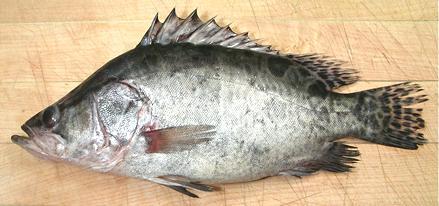 [Chinese Perch; Siniperca chuatsi]
[Chinese Perch; Siniperca chuatsi]
A fresh water fish native to China and the Amur River basin, Mandarin Fish is an aggressive predator feeding entirely on the young of other fish species. This fish is called for in many Chinese fish recipes but is very rare here in Southern California - and rather expensive when it is available. Now farmed as well as caught wild, this fish can grow to nearly 28 inches and 17 pounds, but the photo specimen was 11-1/4 inches long and weighed 15-5/8 ounces. USDN Red List status: Not Evaluated.
More on the Perch Families.
Cooking: .This fish has flesh of a rather delicate taste. For this reason I recommend against pan frying because you'll mainly taste you oil and whatever you dusted the fillets with. It is very good poached and served with a delicate sauce that does not overwhelm (I use 1/3 lemon juice, 2/3 white wine with a just little butter and a little chili).
The flesh of this fish remains firm enough for most wet cooking methods. It can be used in soup, but add it near the end. Fillets tend to split lengthwise along the seams, but doen't flake apart much until you want them to. Flakes are quite large.
Buying: I have purchased whole, uncleaned fish at a very large Asian market (San Gabriel SuperStore) in Los Angeles. I have seen it nowhere else, and at U.S. $6.99 per pound for whole, uncleaned fish it is among the very highest price fish in the Asian markets.
Scales: This fish is covered with small scales that have good adhesion so some vigor is needed to scrape them off. Some won't scrape and will need to be shaved off with the sharp edge of your prep knife..
Cleaning: The guts and membrains inside this fish are tough and relatively hard to pull. You'll need to use your kitchen shears more than with most fish, and especilly to cut out the gills which are in hard.
Fillets: The skin is a bit tough, but otherwise this fish fillets fairly easily. Cut down to the backbone, then over the backbone at the tail end and forward to the rib cage. Cut the ribs from the backbone with kitchen shears and pull them from the fillet with long nose pliers. They pull a bit hard but take almost no flesh. There are quite a few centerline spines but they're in tight and too soft to pull. They don't seem to be a problem after cooking.
Yield: I recomend removing the skirt to the extent of the inside membrane because it can have an "off" taste. You only loose 3/8 ounce per fillet by doing so. A 15-5/8 ounce fish yielded 6-1/8 ounces of skin-on fillet (39%) and 5-5/8 ounces skin-off (36%). Both yields are with the skirt cut off. The yield is low because of a large head and heavy bones. Use those to make stock.
Skin: Skin shrink is fairly strong and will curl fillets. It does not have a strong or "off" taste, but is a bit stronger than the flesh. The skin is quite tough, so it's easy to remove using the standard long knife and cutting board method.
Stock: The head (split), fins and bones, simmered slowly for 30 to 40 minutes, make a very nice almost clear stock with mild flavor. Very usable.
sf_mandarz 110320 - www.clovegarden.com